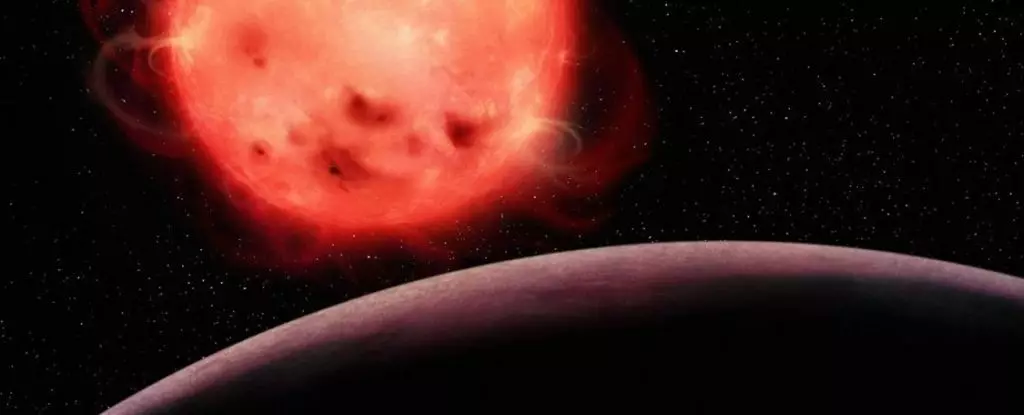Earlier this year, the astronomical community was disheartened when the James Webb Space Telescope (JWST) revealed that TRAPPIST-1b, one of the most Earth-like exoplanets ever discovered, lacks a detectable atmosphere. Despite its similarities in size to Earth, being 1.4 times the mass and 1.1 times the radius, this exoplanet is still uninhabitable due to the absence of an atmosphere that could protect it from the scorching radiation of its host star. Through mid-infrared photometric observations, scientists discovered this unwelcome truth, shedding light on the unique nature of TRAPPIST-1b. However, recent near-infrared spectroscopic observations conducted by the JWST have brought to attention another factor that may hinder accurate measurements of this exoplanet: the behavior of its host star.
While TRAPPIST-1b remains inhospitable for life as we know it, these new findings by astronomer Olivia Lim from the University of Montreal indicate that stellar contamination could generate false detections of molecules unrelated to the exoplanet. Ryan MacDonald, an astrophysicist from the University of Michigan, explains, “Our observations did not see signs of an atmosphere around TRAPPIST-1b. This tells us the planet could be a bare rock, have clouds high in the atmosphere, or have a very heavy molecule like carbon dioxide that makes the atmosphere too small to detect. But what we do see is that the star is absolutely the biggest effect dominating our observations, and this will do the exact same thing to other planets in the system.”
One of the challenges encountered in studying exoplanet atmospheres stems from the fact that stars do not have a uniform brightness. Starspots, similar to sunspots on our own star, can cause dimming, while faculae represent spots of brightness. These fluctuations in a star’s brightness significantly impact spectroscopic observations of exoplanet atmospheres. These observations occur when an exoplanet transits between its host star and us, causing the star’s light to slightly dim. However, some of the starlight passes through the exoplanet’s atmosphere around the rim of the planetary disk. Scientists analyze changes in the spectrum of light during transit, using these changes to search for the signatures of specific molecules that absorb and re-emit particular wavelengths of light. If the star’s light remained constant, the task would be relatively straightforward. Unfortunately, the researchers discovered that stellar activity can heavily contaminate spectroscopic observations.
Lim explains the challenges faced, stating, “In addition to the contamination from stellar spots and faculae, we saw a stellar flare, an unpredictable event during which the star looks brighter for several minutes or hours. This flare affected our measurement of the amount of light blocked by the planet. Such signatures of stellar activity are difficult to model, but we need to account for them to ensure that we interpret the data correctly.”
To account for stellar contamination, the team conducted two analyses of the data: one with stellar contamination removed and the other with it left intact. Surprisingly, both results appeared quite similar. Ultimately, the spectrum of TRAPPIST-1b remained largely unchanged regardless of the presence or absence of stellar contamination. This reaffirmed the previous mid-infrared photometric findings indicating the absence of an atmosphere around the exoplanet. Nevertheless, the team’s research underscored the importance of considering stellar contamination before analyzing data. This newfound understanding presents a valuable opportunity for future studies.
The TRAPPIST-1 system is home to seven exoplanets, with three residing in the star’s habitable zone. These planets exist at a comfortably temperate distance, neither too hot nor too cold for life as we know it. While the JWST has yet to observe these habitable zone worlds, these recent revelations about stellar contamination will inform future research. Scientists can now integrate this factor into their analyses, ensuring a more accurate understanding of exoplanetary atmospheres.
As we continue to explore the mysteries of our universe, it is imperative to exercise critical thinking and self-reflection in our scientific endeavors. The initial disappointment stemming from TRAPPIST-1b’s lack of an atmosphere has led us to delve deeper into the intricacies of exoplanet observations. By uncovering the impact of stellar contamination and emphasizing its significance in future studies, astronomers and astrophysicists are primed to improve our understanding of exoplanetary atmospheres. With the JWST poised to study the habitable zone worlds in the TRAPPIST-1 system and armed with this newfound knowledge, we are better equipped to unlock the secrets of potential life beyond our solar system.



Leave a Reply